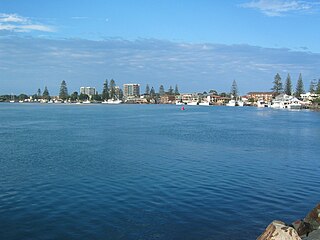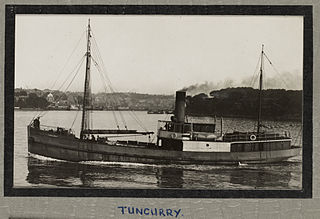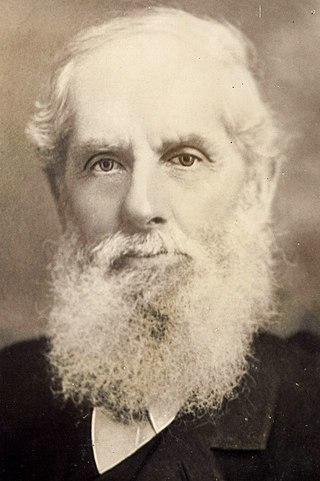
The Cockatoo Island Dockyard was a major dockyard in Sydney, Australia, based on Cockatoo Island. The dockyard was established in 1857 to maintain Royal Navy warships. It later built and repaired military and battle ships, and played a key role in sustaining the Royal Australian Navy. The dockyard was closed in 1991, and its remnants are heritage listed as the Cockatoo Island Industrial Conservation Area.

HMAS Torrens was a River-class destroyer escort of the Royal Australian Navy (RAN). Torrens entered service in 1971, and was active until her decommissioning in 1998.

Forster is a coastal town in the Mid North Coast region of New South Wales, Australia, in the Mid-Coast Council LGA, about 308 km north-north-east of Sydney. It is immediately adjacent to its twin, Tuncurry, which is the smaller of the two towns. Forster is known for its stunning waters and Manning Valley beauty.

Avoca Beach is a coastal suburb of the Central Coast region of New South Wales, Australia, about 95 kilometres (59 mi) north of Sydney. Avoca Beach is primarily a residential suburb, Avoca Beach is also a popular tourist destination. Avoca Beach is known for its surfing and state (regional) surf competitions. It is located within the Central Coast Council local government area.

The Garden Island Naval Chapel is a heritage-listed non-denominational Christian chapel located in the heritage-listed Garden Island Naval Precinct that comprises a naval base and dockyard in the inner eastern Sydney suburb of Garden Island in the City of Sydney local government area of New South Wales, Australia.

Tuncurry is a coastal town in the Mid North Coast region of New South Wales, Australia, in the Mid-Coast Council LGA, about 308 km (191 mi) north north east of Sydney. It is immediately adjacent to its twin town of Forster, which is the larger of the two towns.
Port Weller Dry Docks was a shipbuilder on the Welland Canal at the Lake Ontario entrance. The shipbuilder was founded in 1946 and the site was initially owned by the Government of Canada for storage purchases. The shipyard expanded to include ship repair, and reconstruction work. In 1956, the drydock was sold to the Upper Lakes Shipping Company, which began the construction of vessels at the site. The shipyard twice went insolvent, most recently in 2015. Port Weller Dry Docks was used to build, refit and repair cargo vessels.

Glen Haven is a restored port village on the shore of Lake Michigan on the Leelanau Peninsula within the now Sleeping Bear Dunes National Lakeshore. Attractions include the Lake Michigan beach, a restored General Store and Blacksmith Shop. The unincorporated community is located in Glen Arbor Township.

HMAS Stalwart (H14) was an Admiralty S class destroyer of the Royal Australian Navy (RAN). Built for the Royal Navy during World War I, the ship was not completed until 1919, and spent less than eight months in British service before being transferred to the RAN at the start of 1920. The destroyer's career was uneventful, with almost all of it spent operating along the east coast of Australia. Stalwart was decommissioned at the end of 1925, sold for ship breaking in 1937, and scuttled in 1939.

The Skinner & Eddy Corporation, commonly known as Skinner & Eddy, was a Seattle, Washington-based shipbuilding corporation that existed from 1916 to 1923. The yard is notable for completing more ships for the United States war effort during World War I than any other West Coast shipyard, and also for breaking world production speed records for individual ship construction.

The Tuncurry was a wooden carvel screw steamer built in 1903 at Cape Hawke in the Australian state of New South Wales, that was wrecked when she sprang a leak whilst carrying explosives, cement, whiskey, jam and other general cargo between Sydney and Brisbane. She was lost off Barrenjoey Head, Broken Bay, New South Wales on 22 October 1916.

The Fitzroy was a steel-hulled steamship built in 1912 at Old Kilpatrick, Scotland in 1912. Thirty-one people were killed when Fitzroy capsized in a gale whilst carrying a general cargo between Coffs Harbour and Sydney off Cape Hawke, New South Wales on 26 June 1921.

HMAS Uralba was an auxiliary minefield tender and armament stores carrier operated by the Royal Australian Navy (RAN) during World War II. She was launched in 1942 by Ernest Wright, Tuncurry, New South Wales as Uralba for the North Coast Steam Navigation Company. Requisitioned by the RAN while under construction on 13 July 1942 and commissioned on 22 November 1942. After being returned to her owners and being sold and used for a number of purposes she was sunk on 4 November 1971 to create an artificial reef off Carrum Creek, in Port Phillip Bay.

HMAS Allenwood (FY18) was an auxiliary minesweeper operated by the Royal Australian Navy (RAN) during World War II. She was launched in 1920 by Ernst Wright at Tuncurry, New South Wales, Australia as Allenwood for Allen Taylor and Co. Ltd. The ship operated along the east coast of Australia, and was requisitioned by the RAN on 27 July 1941. She was returned to her owners in 1946 before being wrecked near Norah Head on 14 September 1951.
Poole & Steel was a major Australian engineering, railway rolling stock manufacturer and shipbuilding company. It had facilities located in Balmain, New South Wales and Osborne, South Australia.

The North Coast Steam Navigation Company was a shipping company that operated in Australia, formed as the Grafton Steam Navigation Company in 1855. The company was later renamed the Clarence & Richmond River Steam Navigation Company before being renamed in December 1888 as the Clarence, Richmond & Macleay River Steam Navigation Company.

John Wright was a 19th-century Australian shipbuilder, sawmiller and businessman.

The Tuncurry II was a wooden carvel screw steamer built in 1909 at Tuncurry, Australia.

US Army WT85 Protrude is a tow/tug boat built in 1943 by John Wright and Son Shipyards, in Tuncurry, Australia. After the entry of the United States in World War 2 in 1941, The United States Army ordered five 45-foot-long wooden tug/tow boats through the Ministry of Munitions. Wooden support craft were preferred over metal-hulled ships for reasons of security against mines.

Rock Davis (1833-1904) was a shipbuilder, mainly associated with his shipyard, the Rock Davis shipyard, colloquially known as 'the Big Shed', on Brisbane Water at Blackwall, New South Wales, Australia. After his death, the business of ship building was carried on by his second son, also Rock Davis. The shipyard constructed around 165 wooden-hulled vessels, between 1862 and 1913.






















